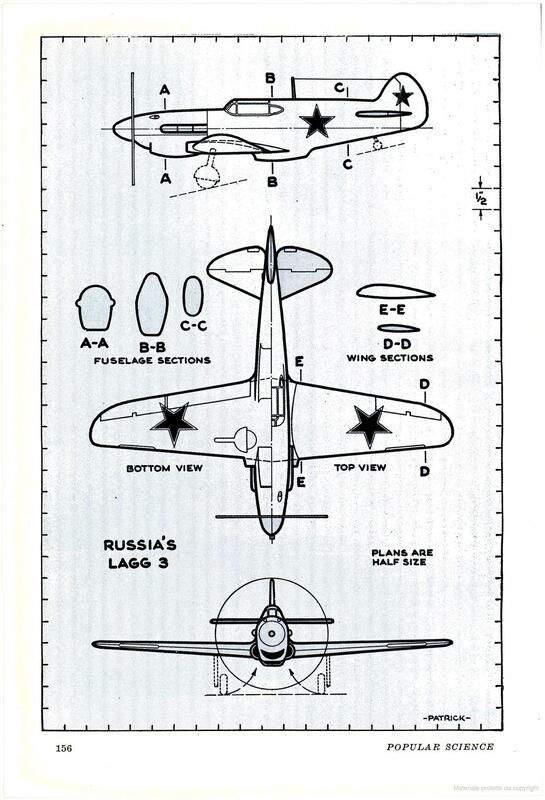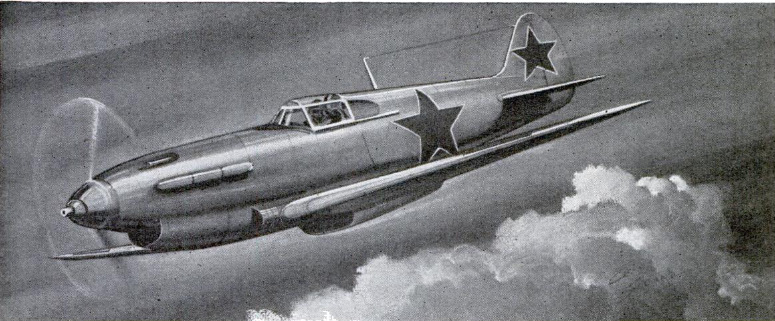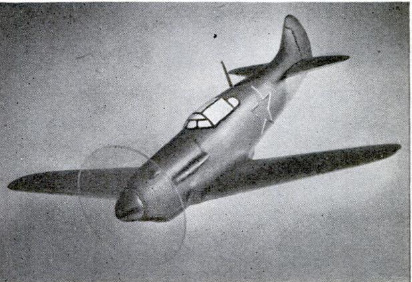Modeling Russia's lagg 3 fighter
Item
-
Title (Dublin Core)
-
Modeling Russia's lagg 3 fighter
-
Article Title and/or Image Caption (Dublin Core)
-
Modeling Russia's lagg 3 fighter
-
extracted text (Extract Text)
-
CONSIDERING the number of aircraft
designs experimented with by all bel-
ligerents and the high rate of obsolescence
of planes tested in action, the quality of the
Red Air Fleet's Lagg 3 can best be described
by the statement that it hasn't yet worn
out. A stand-by throughout the entire Euro-
pean war, this fighter covered every Russian
front and everywhere proved itself an ex-
pensive visitor for the foe.
Russia’s shortage of metal and metal
workers made it necessary to employ a
composite wood-and-metal construction. A
1,200-hp. liquid-cooled engines gives the
Lagg 3 a speed of about 350 m.p.h. Its arma-
ment consists of a single 20-mm. cannon
in the nose and two 12.7-mm. machine guns.
The plane is 29’ long and has a wing span
of 32.
Because of its trim lines, modeling this
plane presents no unusual problems for the
craftsman. Balsa or white pine may be
used equally well, and the choice
depends only on availability and
preference. A block of about 1”
by 2” by 7” is needed for the fuse-
lage. First draw the profile on the
block and cut away the excess
wood; repeat this process for the
top view; and then carefully carve
and sand it down to the shape
called for in the drawing.
The wing should be made of an-
other single piece. Cut a corre-
sponding notch in the bottom of the
fuselage to receive the wing and
then glue it in place. Fill in the
crevices with plastic composition
wood. The left-hand side of the
center drawing gives a bottom view
of this construction. Tail surfaces, formed
separately, should be shaped as shown.
Assemble the entire model before paint-
ing. Apply several coats of wood filler and
sand between each coat with wet-or-dry
sandpaper. The model illustrated below
was given two coats of green-brown airplane
dope on the upper surface and two coats of
sky blue underneath. Decals of the Russian
insignia were purchased at a hobby store.
A whirling propeller effect is obtained by
gluing a celluloid disk behind the propeller
spinner. The cockpit is painted white with
a fine-line black trim. All control-surface
effects are obtained with thin black lines.
-
Language (Dublin Core)
-
eng
-
Date Issued (Dublin Core)
-
1945-07
-
pages (Bibliographic Ontology)
-
155-157
-
Rights (Dublin Core)
-
Public domain
-
Archived by (Dublin Core)
-
Sami Akbiyik
-
Marco Bortolami (editor)
 Popular Science Monthly, v. 147, n. 1, 1945
Popular Science Monthly, v. 147, n. 1, 1945






